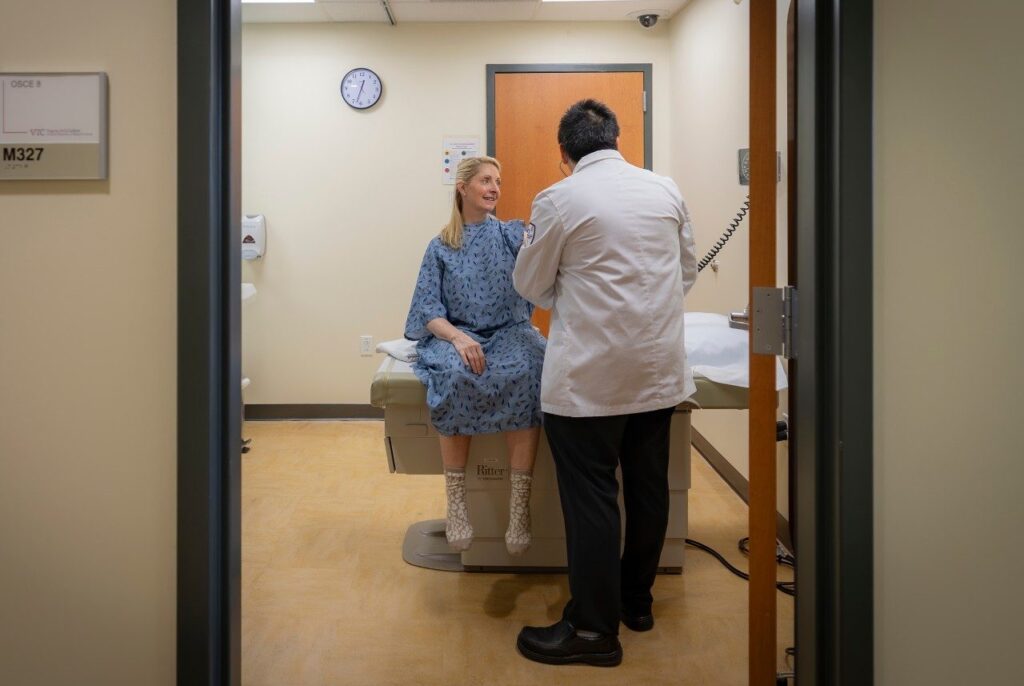It takes a village of dedicated individuals to ensure the success of students at the Virginia Tech Carilion School of Medicine (VTCSOM). The school’s standardized patients, for example, represent a wide range of interests and demographics and play a critical role in helping students practice their clinical skills:
Robyn Dubinsky, 60
Former fitness instructor
Avid doodler, interior design fanatic
Joe Austin, 72
Retired from Norfolk Southern
Church trustee, passionate golfer
Maggie Layman, 20
Student
Singer, cat mama
Three very different individuals with one thing in common. They are all standardized patients and are trained to simulate, in a consistent, standardized manner, a patient in a medical situation. Just as the 65 standardized patients at the medical school represent varied demographics, the patients that future doctors will treat also will come from any number of physical, social, environmental, ethnic, and economic populations.
“Everything we do comes down to demographics,” said Sharita Brown, clinical skills manager. “Our students gain valuable experience with various social determinants of health along with the medical condition being portrayed.”
Standardized patient 101
Each standardized patient learns how to act out the symptoms and demeanor of someone with a specific medical condition and is then interviewed and examined by students as if they were in a doctor’s office. The has 10 exam rooms that are equipped to resemble an exam room, with everything the same from the patient’s gown to the medical instruments. These rooms are where students and standardized patients act out their simulation, also called an event.
Dubinsky became a VTCSOM standardized patient six years ago and is regularly called upon to act out conditions such as chest pain, dizziness, and postpartum depression. Standardized patients undergo several hours of training for each case, ensuring that they understand the condition and exactly how to behave and what to say.
“My role is to be a safe person for the students to practice what they’re learning in the classroom,” she said. “In the beginning, a lot of them are nervous, but they have a chance to make mistakes and learn from them in this setting.”
VTCSOM is one of the few medical schools nationally that starts training students with standardized patients during the first week of school. Many schools begin the practice with standardized patients closer to the start of clinical rotations in students’ third year.
“By starting early, they are much more comfortable when it comes time to interact with real patients,” Brown said. She was a stay-at-home mother looking for something to do outside the home when she began working as a standardized patient. Over the years, she took on more responsibilities and is now manager of the program.
They walk in the room and then what?
After retiring in 2011, Austin decided to try being a standardized patient for a short time. Seven years later, and he’s still at it.
“I’m looking at future doctors,” he said. “It’s really exciting.”
What happens during an event? The standardized patient, wearing an exam room gown, is already in the room when the student enters. Students are taught to introduce themselves, wash their hands, and then start talking with the patient about his or her reason for coming in, symptoms, and a number of medical history questions.
Then the student performs an exam that might include skills such as listening with a stethoscope, pressing on the abdomen, and taking blood pressure measurements. No needles are used. After the student leaves the room, the standardized patient completes an evaluation. Each room is outfitted with two cameras that record the sessions so that faculty and students can review the session to see what went well and what could be improved.
For students who may be struggling, Austin offers some gentle, grandfatherly advice.
“I tell them, ‘You’re here in medical school because you belong here. You’re nervous because you want to do well. That’s human nature.’”

Austin’s enthusiasm about the program led him to acquire a new set of skills and become a physical training associate, teaching students how to conduct a physical exam and use various instruments in the exam rooms.
No experience necessary
Layman became a standardized patient because her goal is to one day practice osteopathic medicine.
“I love doing this,” she said. “It makes me feel like I’m part of something bigger than myself.”
She prides herself on the excruciating pain she displays when she’s acting out appendicitis. The script calls for her to pretend like she’s in the worst pain of her life.
“My portrayal is so dramatic that sometimes the students are afraid to come near me,” she said with a laugh.
Although some of medical school’s standardized patients have a theater background, that experience is not necessary. The school teaches everything a standardized patient needs to know.
“Being a standardized patient is rewarding yet hard work,” Brown said. “It’s time consuming, but our standardized patients are committed to helping with our students’ education.”
Dubinsky said the sense of satisfaction has that kept her keenly involved in the program.
“These are the kinds of doctors I want my grandchildren to see one day, and I’m proud to have a small part in that,” she said.
To learn more and how to apply, contact Mary Stuart Van Metre for more information.
By Catherine Doss

